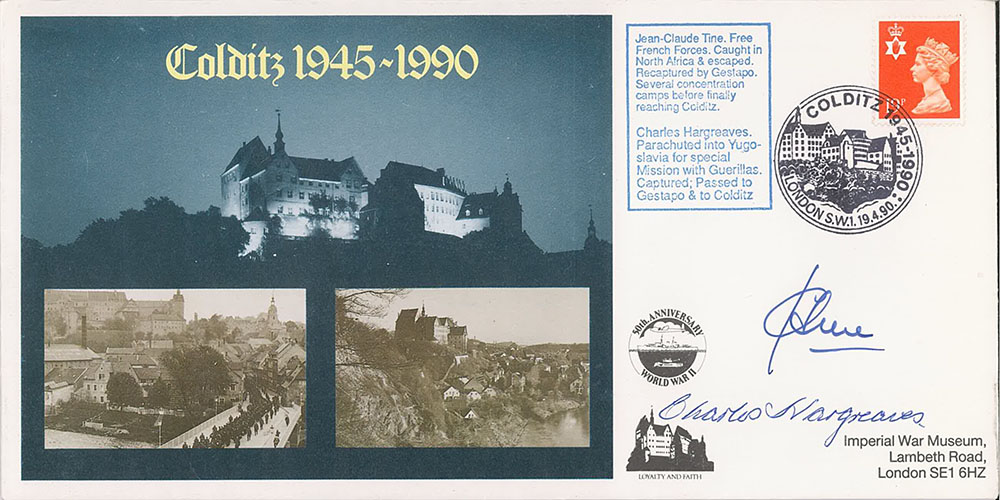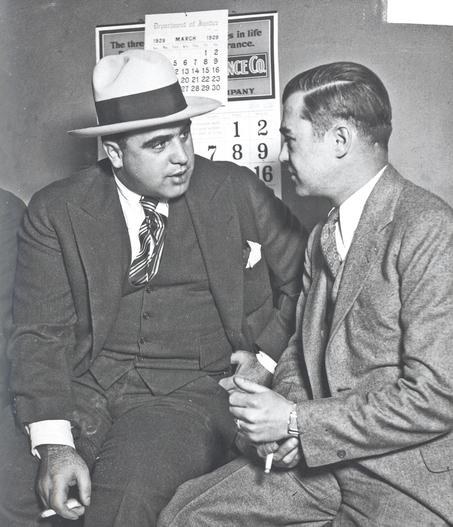Colditz Castle - Oflag 1VC

Colditz Castle
The first known reference to Colditz Castle was in 1014.
It was a hunting lodge and home for the Dukes of Saxony until 1753 becoming a prison in 1800 and then a lunatic asylum in 1828. The Castle then moved on to be a concentration camp in 1933 before a change of use to be a arbeitsdienst ( labour services ) camp for Hitler Youth. As it was thought to be escape proof it was turned into a sonderlager or special camp for dangerous prisoners of war in 1939 until 1945. Prisoners that consistently tried to escape at other camps were sent there. It housed many nationalities and by the end of the war 32 escapees were successful in reaching the frontier. Its most well known inmate was Douglas Bader and British escapees included Airey Neave and Pat Reid.
Dambusters AJ-G Pilot Guy Gibson's Lancaster On Operation Chastise

Operation Chastise
I thought that it might be of interest to follow the crew of AJ-G, Guy Gibsons Lancaster on Operation Chastise, the leader of the most remembered bombing raid of World War Two on the Mohne, Eder and Sorpe Dams on the night of the 16th/17th May 1943.
The pilot, Guy Gibson, had already flown over 172 sorties before he was requested to form 617 Squadron with its main purpose being to carry out Operation Chastise. He was not an easy man to please and seemed to make little attempt to be liked, especially by the non-commissioned ranks. However, he proved to had dropped his bomb he kept returning as others dropped theirs to draw the enemy fire away from the attacker. His attacks led to the award of the VC. He died on the night of the 19th September 1944 whilst piloting a Mosquito of 627 Squadron. There is a mystery of the reason for the crash, some say that ‘friendly fire’ from a Lancaster was the cause, others enemy fire and possibly they just ran out of fuel. He is buried near where he crashed at Steenbergen.
The Navigator was Harlo Taerum, commonly known as Terry by the crew of Norwegian descent. He had emigrated to Canada when younger and joined the RCAF. He was awarded the DFC after the Raid. He was killed on the 16th September 1943 whilst on the infamous Dortmund-Ems Canal attack and is buried at Reichswald Cemetery.
Operation Chastise The Wireless Operator was Robert Hutchinson who had flown with Gibson before in 106 Squadron. Before the Dambusters Raid, he had been awarded the DFC and received a bar to that decoration for Chastise. He was also shot down on the Dortmund-Ems Canal Raid on the 16th September 1943 and is also buried at Reichswald Cemetery.
The Flight Engineer was Flight Sergeant John Pulford who joined the RAF just before the war started, becoming a Flight Engineer in 1942. He was awarded the DFM for his part in the operation. He was killed on the 13th February 1944 while returning to Woodhall Spa in an accident and was buried in Hull Northern Cemetery.
The Bomb Aimer was Frederick Spafford who had previously flown with Terry Taerum in 50 Squadron and was awarded the DFM after Chastise. As Gibson led the attack Spafford pressed the button that dropped the first bomb. He was also killed on the 16th September 1943 Dortmund-Ems attack and is buried at Reichswald Cemetery.
The Front Gunner was Flight Sergeant George Deering who joined the RCAF in 1940 and was awarded the DFC after the raid as his commission had come through just before the raid. He was killed on the 16th September 1943 on the Dortmund-Ems Canal attack and is buried at Reichswald Cemetery.
The Rear Gunner was Richard Trevor-Roper who was 617 Squadrons Gunnery Officer. He was awarded the DFC for his part in Chastise. He was killed on 30/31st March 1944 attacking Nuremberg and is buried in Durnbach War Cemetery.
So not one of the crew survived the war with 4 of the 7 being killed in one night on the Dortmund-Ems Canal attack
For more information on AJ-G and all the other aircrew involved in Operation Chastise treat yourself to Charles Fosters excellent book The Complete Dambusters.
What Did Al Capone And Butch O'Hare Have In Common.


Story Number One
Many Years ago, Al Capone virtually owned Chicago. Capone wasn’t famous for anything heroic. He was notorious for enmeshing the windy city in everything from bootlegged booze and prostitution to murder.
Capone had a lawyer nicknamed “Easy Eddie.” He was Capone’s lawyer for a good reason. Eddie was very good! In fact, Eddie’s skill at legal manoeuvring kept Big Al out of jail for a long time. To show his appreciation, Capone paid him very well.. Not only was the money big, but Eddie got special dividends, as well. For instance, he and his family occupied a fenced-in mansion with live-in help and all of the conveniences of the day. The estate was so large that it filled an entire Chicago City block. Eddie lived the high life of the Chicago mob and gave little consideration to the atrocity that went on around him.
Eddie did have one soft spot, however, He had a son that he loved dearly. Eddie saw to it that his young son had clothes, cars, and a good education. Nothing was withheld. Price was no object. And, despite his involvement with organized crime, Eddie even tried to teach him right from wrong. Eddie wanted his son to be a better man than he was. Yet, with all his wealth and influence, there were two things he couldn’t give his son; he couldn’t pass on a good name or a good example.
One day, Easy Eddie reached a difficult decision. Easy Eddie wanted to rectify wrongs he had done. He decided he would go to the authorities and tell the truth about Al”Scarface” Capone, clean up his tarnished name, and offer his son some resemblance of integrity. To do this, he would have to testify against The Mob, and he knew that the cost would be great. So, he testified.
Within the year, Easy Eddie’s life ended in a blaze of gunfire on a lonely Chicago Street. But in his eyes, he had given his son the greatest gift he had to offer, at the greatest price he could ever pay.. Police removed from his pockets a rosary, a crucifix, a religious medallion, and a poem clipped from a magazine.
The poem read:
“The clock of life is wound but once, and no man has the power to tell just when the hands will stop, at late or early hour. Now is the only time you own. Live, love, toil with a will. Place no faith in time For the clock may soon be still.”
Story Number Two
World War II produced many heroes. One such man was Lieutenant Commander Butch O’Hare. He was a fighter pilot assigned to the aircraft carrier Lexington in the South Pacific.
One day his entire squadron was sent on a mission. After he was airborne, he looked at his fuel gauge and realized that someone had forgotten to top off his fuel tank. He would not have enough fuel to complete his mission and get back to his ship. His flight leader told him to return to the carrier. Reluctantly, he dropped out of formation and headed back to the fleet. As he was returning to the mother ship, he saw something that turned his blood cold; a squadron of Japanese aircraft was speeding its way toward the American-fleet.
The American fighters were gone on a sortie, and the fleet was all but defenceless. He couldn’t reach his squadron and bring them back in time to save the fleet. Nor could he warn the fleet of the approaching danger. There was only one thing to do. He must somehow divert them from the fleet.
Laying aside all thoughts of personal safety, he dove into the formation of Japanese planes. Wing-mounted 50 caliber’s blazed as he charged in, attacking one surprised enemy plane and then another. Butch wove in and out of the now broken formation and fired at as many planes as possible until all his ammunition was finally spent.
Undaunted, he continued the assault. He dove at the planes, trying to clip a wing or tail in hopes of damaging as many enemy planes as possible, rendering them unfit to fly. Finally, the exasperated Japanese squadron took off in another direction.
Deeply relieved, Butch O’Hare and his tattered fighter limped back to the carrier. Upon arrival, he reported in and related the event surrounding his return. The film from the gun-camera mounted on his plane told the tale. It showed the extent of Butch’s daring attempt to protect his fleet. He had, in fact, destroyed five enemy aircraft. This took place on February 20, 1942, and for that action, Butch became the Navy’s first Ace of W.W.II, and the first Naval Aviator to win the Medal of Honor.
A year later Butch was killed in aerial combat at the age of 29. His hometown would not allow the memory of this WW II hero to fade, and today, O’Hare airport in Chicago is named in tribute to the courage of this great man.
So, the next time you find yourself at O’Hare International, give some thought to visiting Butch’s memorial displaying his statue and his Medal of Honor. It’s located between Terminals 1 and 2.
SO WHAT DO THESE TWO STORIES HAVE TO DO WITH EACH OTHER?
Butch O’Hare was “Easy Eddie’s” son.

